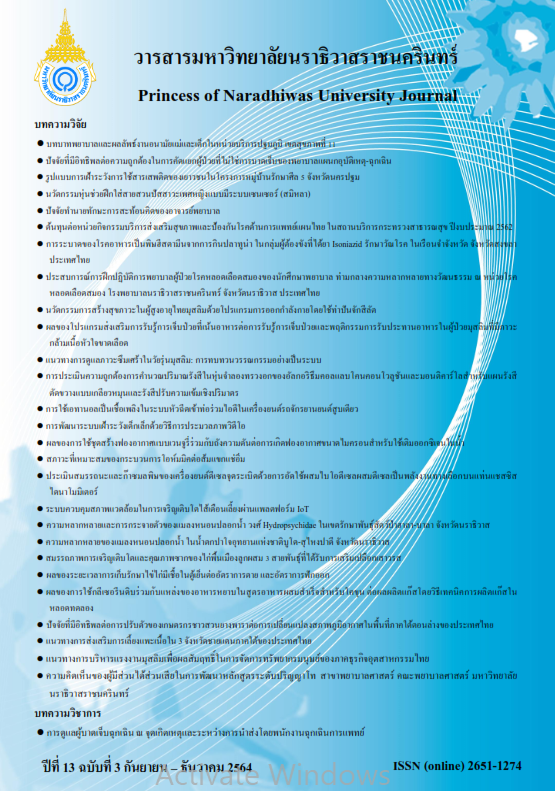An Outbreak of Histamine Food Poisoning after Ingestion Longtail Tuna in Prisoners Taking Isoniazid from Songkhla Province Prison, Songkhla Province, Thailand
Keywords:
Histamine food poisoning, Scombridae fish, IsoniazidAbstract
On 3 December 2020, an outbreak of histamine poisoning occurred in the Songkhla province prison (SPP), Songkhla, Southern of Thailand. A total of 19 cases were identified. A suspected cause was a Longtail Tuna cooked as a sour curry with papaya delivered from a downtown restaurant. The aim of the study was to investigate the reason for the outbreak of histamine poisoning in the SPP. A case-control study was conducted among 19 cases of histamine poisoning and 33 unmatched controls from the same prison. Both cases and controls were diagnosed with pulmonary tuberculosis (TB) and still receiving anti-tuberculosis drugs. The toxic histamine concentration level in cooked Longtail Tuna sour curry with papaya and clinical characteristics of the 19 cases were measured and analyzed. The characteristics of cases and controls were compared. 19 (36.5%) of 52 prisoners in SPP who consumed the Tuna fish had developed allergic reactions. The manifestation of symptoms was skin rash 100%, itching 100%, dizziness 94.7%, headache 78.9%, nausea 47.4%, vomiting 5.3%, diarrhea 10.5%, and chest tightness 42.1%. The median time from consumption to developing symptoms was 40 minutes. Most prisoners abruptly recovered with antihistamine and symptomatic treatments. All cases were taking isoniazid (INH) as an anti-tuberculosis treatment. The elevated histamine level of 10 mg/kg of tuna was measured in the cooked Tuna. However, the level was still lower than the hazardous levels (50 mg/kg of food). INH suppresses both monoamine oxidase and diamine oxidase, thus decreasing histaminase activity causes more toxic of histamine poisoning. This outbreak of histamine poisoning was a result of the interaction between INH and fish containing histamine at the levels below hazard level. In patients with active tuberculosis especially those who were treated with INH, the drug and food containing histamine should be avoided to prevent histamine poisoning.
References
Biji, K.B., Ravishankar, C.N., Venkateswarlu, R., Mohan, C.O., & Gopal, T.K. (2016). Biogenic amines in seafood: A review. Journal of Food Science and Technology, 53(5), 2210-2218.
Colombo, F.M., Cattaneo, P., Confalonieri, E., & Bernardi, C. (2018). Histamine food poisonings: A systematic review and meta-analysis. Critical Reviews in Food Science and Nutrition, 58(7), 1131-1151.
Demoncheaux, J.-P., Michel, R., Mazenot, C., Duflos, G., Iacini, C., Delaval, F., … Renard, J.-C. (2012). A large outbreak of scombroid fish poisoning associated with eating yellowfin tuna (Thunnus albacares) at a military mass catering in Dakar, Senegal. Epidemiology & Infection, 140(6), 1008-1012.
Food and Agriculture Organization of the United Nations (Ed.). (2013). Joint FAO meeting report expert meeting on the public health risks of histamine and other biogenic amines from fish and fishery products. Food and Agriculture Association of the United Nations.
Gagic, M., Jamroz, E., Krizkova, S., Milosavljevic, V., Kopel, P., & Adam, V. (2019). Current Trends in Detection of Histamine in Food and Beverages. Journal of Agricultural and Food Chemistry, 67(3), 773-783.
Hungerford, J.M. (2010). Scombroid poisoning: A review. Toxicon, 56(2), 231–243.
Joe Whitworth (2019). Histamine outbreaks could increase in Europe. Food Safety News. Retrieved June 12, 2021 from https://www.foodsafetynews.com/2019/06/histamine-outbreaks-could-increase-in-europe/
Kaneko, T., & Ishigatsubo, Y. (2005). Isoniazid and Food Interactions: -Fish, Cheese, and Wine. Internal Medicine, 44(11), 1120–1121.
Kang, C.R., Kim, Y.Y., Lee, J.I., Joo, H.D., Jung, S.W., & Cho, S.-I. (2018). An Outbreak of Scombroid Fish Poisoning Associated with Consumption of Yellowtail Fish in Seoul, Korea. Journal of Korean Medical Science, 33(38).
Miki, M., Ishikawa, T., & Okayama, H. (2005). An Outbreak of Histamine Poisoning after Ingestion of the Ground Saury Paste in Eight Patients Taking Isoniazid in Tuberculous Ward. Internal Medicine, 44(11), 1133-1136.
Morinaga, S., Kawasaki, A., Hirata, H., Suzuki, S., & Mizushima, Y. (1997). Histamine Poisoning after Ingestion of Spoiled Raw Tuna in a Patient Taking Isoniazid. Internal Medicine, 36(3), 198-200.
Scomberesocidae—An overview | ScienceDirect Topics. (n.d.). Retrieved January 23, 2021, from https://www.sciencedirect.com/topics/agricultural-and-biological-sciences/scomberesocidae
Velut, G., Delon, F., Mérigaud, J.P., Tong, C., Duflos, G., & Boissan, F.V. (2019). Histamine food poisoning: A sudden, large outbreak linked to fresh yellowfin tuna from Reunion Island, France, April 2017. Eurosurveillance, 24(22).
Visciano, P., Schirone, M., Tofalo, R., & Suzzi, G. (2012). Biogenic Amines in Raw and Processed Seafood. Frontiers in Microbiology, 3.
Visciano, P., Schirone, M., Tofalo, R., & Suzzi, G. (2014a). Histamine poisoning and control measures in fish and fishery products. Frontiers in Microbiology, 5.
Visciano, P., Schirone, M., Tofalo, R., & Suzzi, G. (2014b). Histamine poisoning and control measures in fish and fishery products. Frontiers in Microbiology, 5.




